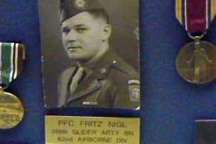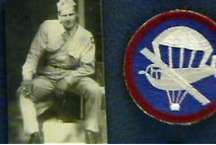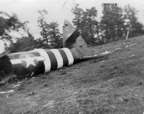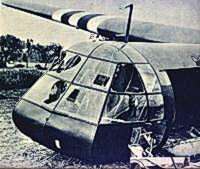|
Hall of Heroes
|
| My father , Alfred
(Fritz) Joseph Nigl, PFC, was a member of the 319th Glider Field
Artillery Battalion from March 1942 until August 1945. He was assigned
as a Radio Man, part of the Forward Observer Team that was assigned
to Battery B during the invasion of Italy.
When the 319th was attached to Col. Darby's Ranger Battalion the
319th was the first glider unit of the 82nd Airborne to see combat
in WWII) and later became one of the first American soldiers to
liberate Naples. He was |
 PFC Alfred (Fritz) Nigl in Hall of Heroes
PFC Alfred (Fritz) Nigl in Hall of Heroes
Click image for larger view |
|
then assigned to Battery C for the
rest of the war. He participated in the D-Day glider landings
at landing zone W at 11 PM June 6, 1944. Near St. Mere Eglise
his British Horsa glider crash-landed. Three of the 11 men aboard
were killed instantly. My father, though injured, saved the life
of a buddy who was too injured to get out of the glider. They
were under heavy German machine gun fire after landing. He Then
fought in the battle for the Merderet River and other engagements
on the Contentin Peninsula. After a few weeks R&R in England,
he participated in Operation Market Garden (see
the quiz) (see
the story) and made another glider assault landing near
Nijmegen, Holland where the 319th went up against the 2nd and
3rd SS Panzer Divisions out of Arnhem. He was also part of the
front line engagements during the Battle of the Bulge when the
82nd was brought up to shore up US front line defensive positions
near Malmedy and St. Vith, Belgium. There the 319th at times fought
hand to hand against forward elements of Joachim Peiper's 1st
Panzer Division (designated LAH for Liebstandarte Adolf Hitler.)
The 319th remained in front line combat positions throughout December
44 and were not relieved until after crossing the Rhine in Feb.
|
 PFC Alfred (Fritz) Nigl in Hall of Heroes
PFC Alfred (Fritz) Nigl in Hall of Heroes
Click image for larger view
|
1945. He was present for all of the
engagements that led to the 319th earning two Presidential Unit
Citations, Three Bronze Arrowheads (three invasions; Italy, France,
and Holland) and four Silver Battle Stars. Let the guys in Battery's
B and C know that he would have been proud of them. He died of
cancer at the age of 66 in 1985.
Thanks
Dr. Alfred James Nigl
|
Towards St. Mere Eglise.
A Paraglider Trooper
Remembers D-Day
PFC Alfred (Fritz) Nigl
|
 Actual Horsa after crashing.
Actual Horsa after crashing.
Click image for a larger view |
D-Day , June 6th, 1944
First person account from PFC. Alfred (Fritz) Nigl,
a Paraglide trooper with the 319th Glider Field Artillery Battalion,
82nd Airborne Division, US Army.
Late in May, 1944, we were moved from around Nottingham,
England to an airfield in the south of England. For about a week, we
practiced loading and unloading the gliders. It was a real tricky situation
because they didn't know when we were going to leave. Finally, we loaded
up and were told the invasion was on. It was just before midnight. We
took off and went across the English Channel.
|

Packed in!
Click image for a
larger view
|
We had about 16 men in our glider (a British Horsa,
a large glider constructed primarily of wood and canvas.) We were
loaded with boxes of ammunition, high explosive shells and powder
for our Battery's 75mm pack howitzers. On the way over, we saw the
Flying Fortresses just above us. They were heading back to England
after making a bombing run. I remember this young kid, from Oklahoma
running around inside the glider. He said " We don't have to
worry, the B-17s |
have killed them all "
But we had plenty to worry about. We saw gliders going right
down into the drink
(English Channel) The tow ropes on those gliders had broken.
In Normandy, the Germans had set poles in the landing
zones- poles with mines attached. Our general was James M. Gavin, he
got some info that our landing zones were mined and the Germans were
waiting, so at the last minute our landing zones were changed, we went
further inland well behind German lines.
As we got closer to our new landing zone, we started
to receive ack-ack (antiaircraft) fire. We saw the tracer bullets coming
right up at us. We hadn't surprised anyone. It seemed the Germans knew
exactly where we were going.
I was sitting down in the rear of the glider,
and holding onto a strap, which was attached to the inside of the glider.
For some reason I took my hand down, then "boom" five bullet
holes appeared right where I had had my hand. If I hadn't moved my hand,
it would have been blown right off.
We were still in the air,
when we hit something going over 100 miles an hour (later we learned
we had hit a tree) . There was just this horrible loud noise, the
sound made you sick to your stomach. Then everything went black,
when I came to, I was lying upside down on my head.
I crawled out of the glider. Several men had been killed in the
crash. The pilot was found pinned to a tree with the landing gear
through his chest. One kid was still alive, I ripped parts off the
glider and used them as stretchers |
 Crashed Horsal
Crashed Horsal |
to carry the dead and wounded to a Paratrooper
Aide station, that wasn't too far away.
It was pitch black, so we set up a machine gun to guard the ammunition,
the Germans were all around us, you could hear them talking and moving
through the brush.
The next morning we unloaded the ammunition onto a jeep and trailer, and
headed towards St. Mere Eglise.
|




